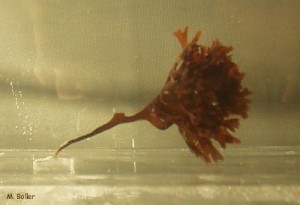Functional morphology of seaweeds
Marine algae of temperate rocky shores, especially in Washington waters, are fascinating because they are so diverse in the way they are constructed. How can so many different, and seemingly delicate, growth forms thrive on a shore pounded by surf? Many of my early contributions focus on how thallus morphology influences the ability of algae to withstand wave forces, while others detail the mechanical properties (strength, stiffness, etc.) of various species. The studies by Michael Boller use a combination of field, laboratory and modeling techniques to illustrate how tissue construction (plant stiffness, thickness, and size) influences the ability of a plant to deform and reconfigure in flow, which in turn influences the flow forces it encounters (Boller and Carrington 2006a, 2006b, 2007). This work extends our basic understanding of how flexible objects, which are less commonly studied by engineers, interact with and modulate water moving past them. Photo Credits (left to right: Meg Boller, Mike Boller.

